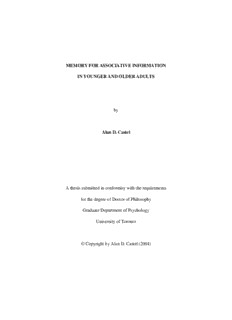
Memory for associative information in younger and - Alan Castel PDF
Preview Memory for associative information in younger and - Alan Castel
MEMORY FOR ASSOCIATIVE INFORMATION IN YOUNGER AND OLDER ADULTS by Alan D. Castel A thesis submitted in conformity with the requirements for the degree of Doctor of Philosophy Graduate Department of Psychology University of Toronto © Copyright by Alan D. Castel (2004) MEMORY FOR ASSOCIATIVE INFORMATION IN YOUNGER AND OLDER ADULTS Alan D. Castel Department of Psychology, University of Toronto Ph.D. 2004 Abstract The present series of experiments examined how aging and divided attention influence memory for item and associative information in a variety of contexts. Previous research has suggested that one reason for older adults’ poorer episodic memory is an impairment in processing and retaining associative information. To examine this, older adults, younger adults, and younger adults under various divided attention conditions studied unrelated word pairs for a later recognition memory test of both single words and different combinations of word pairs (Experiments 1-3). Both older and younger divided attention adults performed less well than the full attention group, with the deficit in associative information being greater than the deficit in item information. In addition, a differentially greater associative impairment was found for the older adults, as shown by their heightened tendency to make false alarm responses to re-paired (conjunction) distracters. These findings are interpreted in a dual-process model of recognition memory, in which older adults rely more on familiarity rather than recollection when processing associative information. The ability to remember other types of associative information was further examined by using cued recall tests of associative memory that varied in terms of the degree of specificity. In these experiments (Experiments 4-6), participants studied items ii that were paired with either related or unrelated units of information, as well as specific numerical information (either quantity or price information). Although older adults had the greatest difficulty remembering specific arbitrary associations, this impairment was reduced when associations were made meaningful (as a result of expertise) or contained a certain degree of schematic support. These results are discussed in terms of how prior knowledge and evaluative processing can influence associative memory, and suggest that a framework of associative memory that emphasizes different levels of associative specificity is necessary to interpret how older adults access associative information. The overall pattern of results imply that observations of age-related differences in memory for associative information depend on differences in available attentional resources, grain size (degree of precision) analyses at both encoding and retrieval, schematic support, and the meaningfulness and specificity of the association. iii Acknowledgements I would like to express my sincere thanks to my advisor Fergus Craik for his expertise, guidance and generosity throughout my graduate training. I would also like to thank Jay Pratt for his constant support and advice, and Lynn Hasher for her insight and guidance. I appreciate the helpful comments and suggestions from Rose Zacks and Nicole Anderson. I am also very grateful to the many members of the laboratory and department that made this research possible and enjoyable. Finally, I would like to especially thank my family and friends, who have provided continuous support and encouragement. iv Table of Contents Abstract ii Acknowledgements iv Table of Contents v List of Tables viii List of Figures ix List of Appendices x Chapter 1: Introduction…………………………………………………………….. 1 A Review of Memory and Aging Research………………………………….. 1 Distinctions between Item and Associative Memory………………………… 3 Previous Examinations of Associative Memory Impairments……………….. 6 Reduced Resources and Memory for Associations…………………………. 9 Overview of Current Research……………………………………………….11 Chapter 2: Divided Attention and Memory for Associative Information……… 13 Introduction………………………………………………………………….. 13 Experiment 1………………………………………………………………… 15 Experiment 1A………………………………………………………… 15 Method…………………………………………………………….. 15 Results and Discussion……………………………………………. 19 Experiment 1B………………………………………………………… 27 Method…………………………………………………………….. 28 Results and Discussion……………………………………………. 28 v Experiment 2……………………………………………………………….... 31 Experiment 2A………………………………………………………… 31 Method…………………………………………………………….. 33 Results and Discussion……………………………………………. 34 Experiment 2B………………………………………………………… 36 Method…………………………………………………………….. 37 Results and Discussion……………………………………………. 37 Experiment 3……………………………………………………………….... 39 Method…………………………………………………………….. 42 Results and Discussion……………………………………………. 44 General Discussion and Summary…………………………………………... 48 Chapter 3: Binding and Memory for Numerical Information………………….. 55 Introduction………………………………………………………………….. 55 Experiment 4………………………………………………………………… 59 Method…………………………………………………………….. 60 Results and Discussion……………………………………………. 62 Experiment 5………………………………………………………………… 66 Method…………………………………………………………….. 67 Results and Discussion……………………………………………. 69 Experiment 6………………………………………………………………… 73 Method……………………………………………………………. 76 Results and Discussion……………………………………………. 78 General Discussion and Summary…………………………………………... 81 vi Chapter 4: General Discussion, Theoretical Contributions, and Implications… 84 General Summary…………………………………………………………… 84 Mechanisms of Associative Memory in Older Adults………………………. 85 Memory for Gist and Specific Information in Older Adults………………... 90 Prior Knowledge, Expertise and Memory for Associations………………… 94 Grain Size, Associative Memory, and Aging………………………….….... 97 Situated Levels of Associative Memory (SLAM) Framework ……………. 99 Summary and Conclusions………………………………………………… 106 References………………………………………………………………………… 109 Tables……………………………………………………………………………… 128 Figures…………………………………………………………………………….. 131 Appendices………………………………………………………………………… 145 vii List of Tables Table Page 2.1 Mean Proportion of “Old” Responses in the Word Pair and Item 128 Recognition Test for Experiments 1A and 1B 2.2 Mean Proportion of “Old” Responses in the Word Pair Recognition Test 129 for Experiments 2A and 2B 2.3 Mean Proportion of “Old” Responses in the Word Pair Recognition 130 Test for Experiment 3 viii List of Figures Figure Page 2.1 Memory Performance (Word Pairs) in Experiment 1A 131 2.2 Memory Performance (Single Words) in Experiment 1A 132 2.3 Discriminability Analysis for Experiment 1A 133 2.4 Memory Performance (Word Pairs) in Experiment 2A 134 2.5 Discriminability Analysis for Experiment 2B 135 2.6 Memory Performance (Word Pairs) in Experiment 3 136 2.7 Discriminability Analysis for Experiment 3 137 2.8 Discriminability as a Function of Corrected Hit Rate for Experiments 1-3 138 3.1 Schematic Outline of Experiment 4 139 3.2 Correct Recall for Numbers and Objects in Experiment 4 140 3.3 Correct Recall of Prices in Experiment 5 141 3.4 Deviation of Incorrect Responses in Experiment 5 142 3.5 Correct Recall of Prices in Experiment 6 143 3.6 Correct Value Category Recall in Experiment 6 144 ix List of Appendices Appendix Page 3.1 Phrases used in Experiment 4 145 3.2 Examples of Items and Prices used in Experiments 5 and 6 146 x
Description: